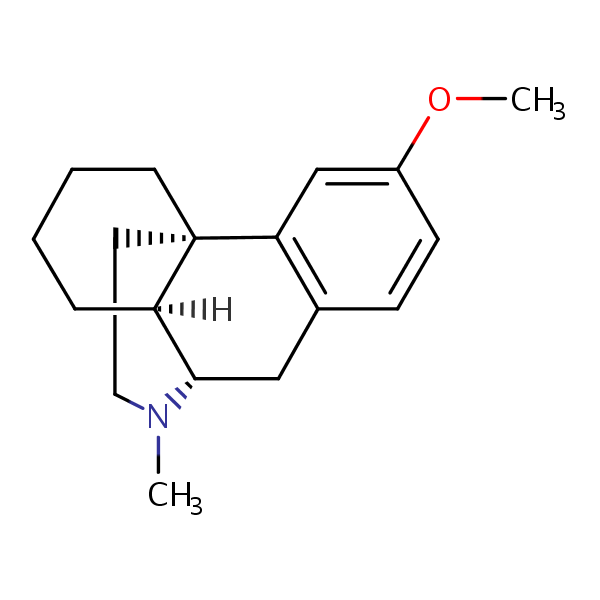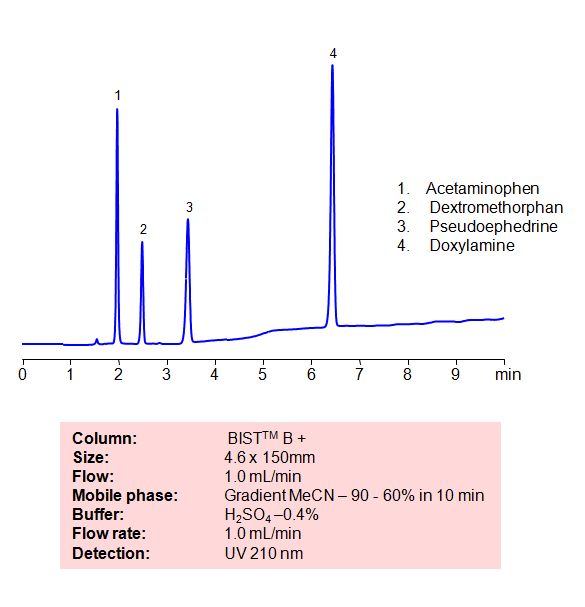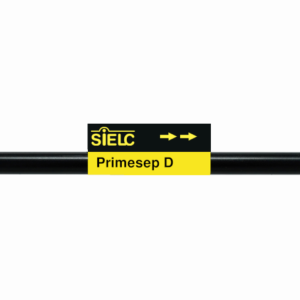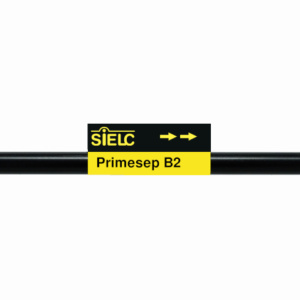| CAS Number | 125-71-3 |
|---|---|
| Molecular Formula | C18H25NO |
| Molecular Weight | 271.404 |
| InChI Key | MKXZASYAUGDDCJ-NJAFHUGGSA-N |
| LogP | 3.79 |
| Synonyms |
|
Applications:
HPLC Method for Analysis of Dextromethorphan on Primesep 100 Column
January 23, 2023
HPLC Method for Analysis of Dextromethorphan on Primesep 100 by SIELC Technologies
Separation type: Liquid Chromatography Mixed-mode
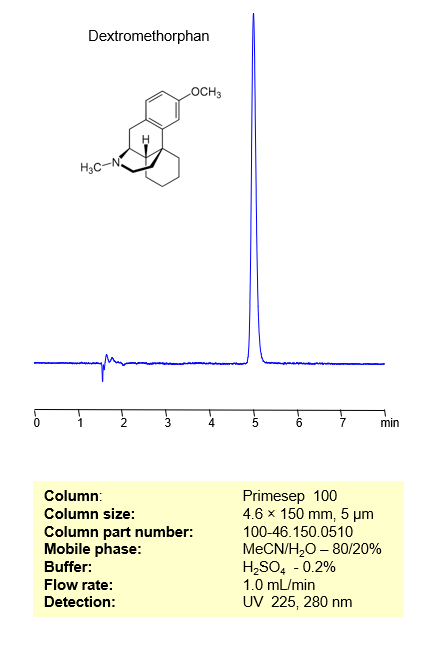
Dextromethorphan is a cough suppressant that works by affecting the cough reflex in the brain. It is commonly found in the over-the-counter cough and cold medicines. Dextromethorphan can be retained and analyzed on a Primesep 100 mixed-mode stationary phase column using an isocratic analytical method with a simple mobile phase of water, Acetonitrile (MeCN), and a Sulfuric acid (H2SO4) buffer. This analysis method can be detected in the low UV regime at 225 and 280 nm.
High Performance Liquid Chromatography (HPLC) Method for Analysis of Dextromethorphan
Condition
| Column | Primesep 100, 4.6×150 mm, 5 µm, 100A |
| Mobile Phase | MeCN/H2O – 80/20% |
| Buffer | H2SO4 – 0.2% |
| Flow Rate | 1.0 ml/min |
| Detection | UV 225, 280 nm |
| Peak Retention Time | 4.81 min |
Description
| Class of Compounds | Drug |
| Analyzing Compounds | Dextromethorphan |
Application Column
Primesep 100
Column Diameter: 4.6 mm
Column Length: 150 mm
Particle Size: 5 µm
Pore Size: 100 A

HPLC Method for Separation of NyQuil Active Ingredients on BIST B+ Column
October 18, 2021
Separation type: Bridge Ion Separation Technology, or BIST™
High Performance Liquid Chromatography (HPLC) Method for Analysis of Acetaminophen, Dextromethorphan, Pseudoephedrine, Doxylamine
Nyquil is a combination of medicines used to treat headaches, fever, body aches, cough, runny nose, sneezing, and sore throat caused by allergies, the common cold, or the flu. Nyquil contains the active ingredients acetaminophen, dextromethorphan HBr, doxylamine succinate, and sometimes, phenylephrine HCl. Acetaminophen is a pain reliever and fever reducer. Dextromethorphan is a cough suppressant. It affects the cough reflex in the brain that triggers coughing. Doxylamine is an antihistamine that reduces the effects of the natural chemical histamine in the body. Histamine can produce symptoms of sneezing, itching, watery eyes, and runny nose. Pseudoephedrine is used to relieve nasal congestion caused by colds, allergies, and hay fever. It is also used to temporarily relieve sinus congestion and pressure. All active compounds of Nyquil can be separated in HPLC on a BIST B+ column. The analytical method uses acetonitrile (ACN) gradient and water with sulfuric acid (H2SO4) as buffer and UV detected at 210 nm.
| Column | BIST B+, 4.6×150 mm, 5 µm, 100A |
| Mobile Phase | Gradient MeCN – 90-60%, 10 min |
| Buffer | H2SO4 – 0.4% |
| Flow Rate | 1.0 ml/min |
| Detection | UV, 210 nm |
| Class of Compounds |
Drug, Basic, Hydrophobic, Ionizable |
| Analyzing Compounds | Acetaminophen, Dextromethorphan, Pseudoephedrine, Doxylamine |
Application Column
BIST B+
BIST™ columns offer a unique and effective way to achieve separations that were traditionally challenging or even impossible with other HPLC columns. With the use of a special mobile phase, these ion exchange columns provide very strong retention for analytes with the same charge polarity as the stationary phase, unlocking new chromatography applications. What makes BIST™ columns stand out is their proprietary surface chemistry, which results in superior selectivity, resolution, and sensitivity. These columns offer a simple, efficient solution for a variety of analytical challenges, making them an excellent choice for researchers and analysts across many different fields. To learn more about the technology that powers BIST™ columns and to explore related applications, check out https://BIST.LC.
Select optionsAcetaminophen (Paracetamol)
Dextromethorphan
Doxylamine
Pseudoephedrine (PSE)

Analysis of Dextromethorphan-Based Composition
July 3, 2013
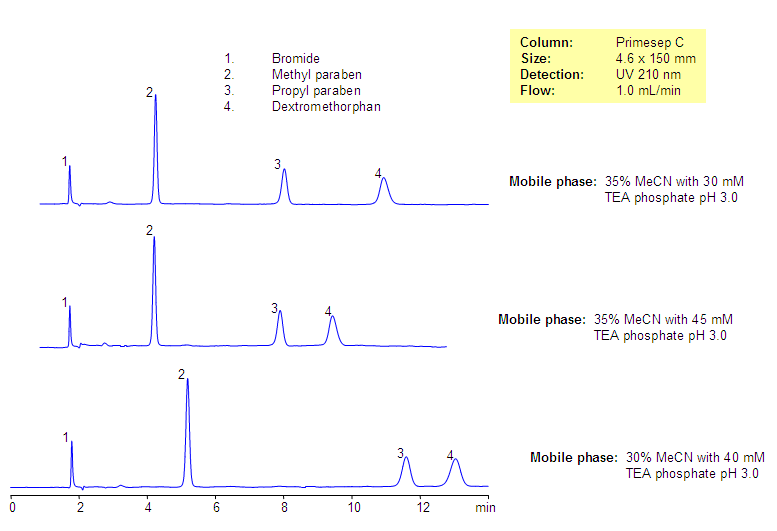
| Column | Primesep C, 4.6×150 mm, 5 µm, 100A |
| Mobile Phase | MeCN/H2O |
| Buffer | TEAPh |
| Flow Rate | 1.0 ml/min |
| Detection | UV, 210 nm |
| Class of Compounds |
Drug, Preservatives, Base, Hydrophobic, Ionizable |
| Analyzing Compounds | Dextromethorphan, Bromide, Methyl Paraben, Propyl Paraben |
Application Column
Primesep C
The Primesep family of mixed-mode columns offers a wide variety of stationary phases, boasting unprecedented selectivity in the separation of a broad array of chemical compounds across multiple applications. Corresponding Primesep guard columns, available with all stationary phases, do not require holders. SIELC provides a method development service available to all customers. Inquire about our specially-tailored custom LC-phases for specific separations.
Select optionsDextromethorphan
Methylparaben
Propylparaben

Analysis of Dextromethorphan-Based Drug composition. Effect on buffer pH
July 3, 2013
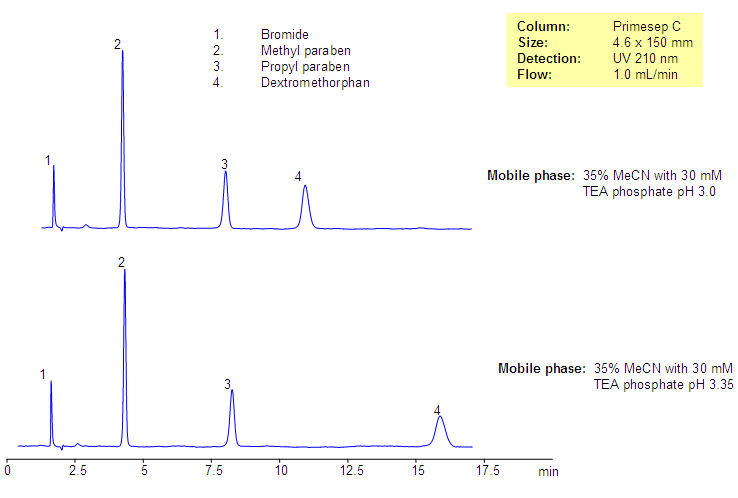
Dextromethorphan is one of the common cough suppressants used in many drug composition. It is in tablets and syrups as an antitussive drug. Composition often has preservatives like parabens. Dextromethorphan is a hydrophobic, basic drug which is used as a bromide salt in drug compositions. Dextromethorphan and two parabens (methyl paraben and propyl paraben) were separated on Primesep C reversed-phase cation-exchange column. Several impurities were observed and are well separated from the main components of the drug composition. Method can be used for various formulations in QC and production environment.
| Column | Primesep C, 4.6×150 mm, 5 µm, 100A |
| Mobile Phase | MeCN/H2O – 35/65% |
| Buffer | TEAPh |
| Flow Rate | 1.0 ml/min |
| Detection | UV, 210 nm |
| Class of Compounds |
Drug, Preservatives, Base, Hydrophobic, Ionizable |
| Analyzing Compounds | Dextromethorphan, Bromide, Methyl Paraben, Propyl Paraben |
Application Column
Primesep C
The Primesep family of mixed-mode columns offers a wide variety of stationary phases, boasting unprecedented selectivity in the separation of a broad array of chemical compounds across multiple applications. Corresponding Primesep guard columns, available with all stationary phases, do not require holders. SIELC provides a method development service available to all customers. Inquire about our specially-tailored custom LC-phases for specific separations.
Select optionsDextromethorphan
Methylparaben
Propylparaben

HPLC Separation of NyQuil Active Ingredients
June 4, 2011
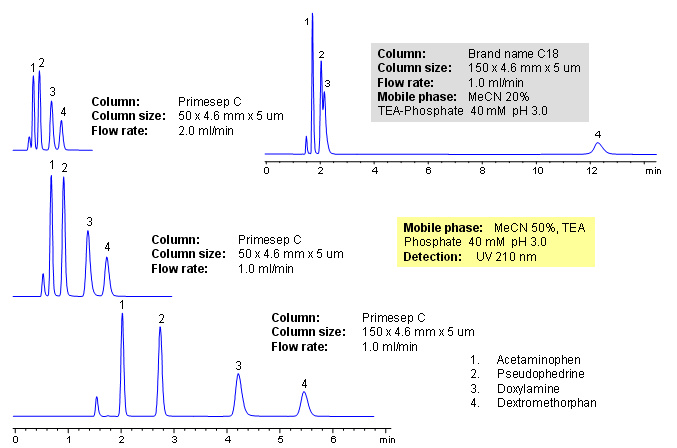
NyQuil is a cough medication produced by Procter&Gamble. It consists of acetaminophen, pseudoephedrine, doxylamine and dextromethorphan. Most of the analytical HPLC methods include either use of ion-pairing reagent or a gradient elution. Mixed-mode chromatography allows to replace long gradient method with short isocratic method. All four compounds are well separated within 3-5 minutes. Methods can be optimized for analysis of other cough composition containing general cough suppressants and pain killers. Method is robust and being validated at several drug companies.
| Column | Primesep C, 4.6×50 mm, 5 µm, 100A |
| Mobile Phase | MeCN |
| Buffer | TEAPh |
| Flow Rate | 1.0 ml/min |
| Detection | UV, 210 nm |
| Class of Compounds |
Drug, Analgetic, Acid, Hydrophilic, Ionizable, |
| Analyzing Compounds | Acetaminophen, Pseudoephedrine, Doxylamine, Dextromethorphan |
Application Column
Primesep C
The Primesep family of mixed-mode columns offers a wide variety of stationary phases, boasting unprecedented selectivity in the separation of a broad array of chemical compounds across multiple applications. Corresponding Primesep guard columns, available with all stationary phases, do not require holders. SIELC provides a method development service available to all customers. Inquire about our specially-tailored custom LC-phases for specific separations.
Select optionsDextromethorphan
Doxylamine
Pseudoephedrine (PSE)

HPLC Separation of Drugs
November 21, 2010
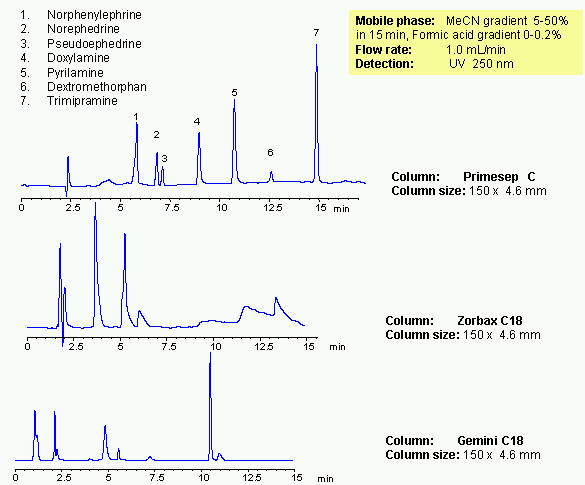
Mixed-mode chromatography allows to separate various hydrophobic and hydrophilic drugs in one HPLC method. Presence of at least two mechanism of retention allows adjust selectivity of separation by changing three parameters: amount of acetonitrile, buffer concentration and buffer pH. Seven common drugs are separated on a Primesep C trimodal HPLC column in gradient method. Method provides alternative selectivity to traditional reversed-phase chromatography. Operational range in which basic compounds are retained the most is from pH 3 to 5. At higher pH, longer retention can be achieved. Mixed-mode chromatography provides longer retention and better peak shapes for basic and acidic analytes. Method can be used in analysis of drugs and pharmaceuticals.
| Column | Primesep C, 4.6×150 mm, 5 µm, 100A |
| Mobile Phase | MeCN |
| Buffer | Formic Acid |
| Flow Rate | 1.0 ml/min |
| Detection | UV, 250 nm |
| Class of Compounds |
Drug, Analgetic, Acid, Hydrophilic, Ionizable, |
| Analyzing Compounds | Norphenylephrine, Norephedrine, Pseudoephedrine, Doxylamine, Pyrilamine, Dextromethorphan, Trimipramine |
Application Column
Primesep C
The Primesep family of mixed-mode columns offers a wide variety of stationary phases, boasting unprecedented selectivity in the separation of a broad array of chemical compounds across multiple applications. Corresponding Primesep guard columns, available with all stationary phases, do not require holders. SIELC provides a method development service available to all customers. Inquire about our specially-tailored custom LC-phases for specific separations.
Select optionsDoxylamine
Norephedrine
Norphenylephrine
Pseudoephedrine (PSE)
Pyrilamine

Separation of Drugs in Mixed-Mode HPLC
August 22, 2010
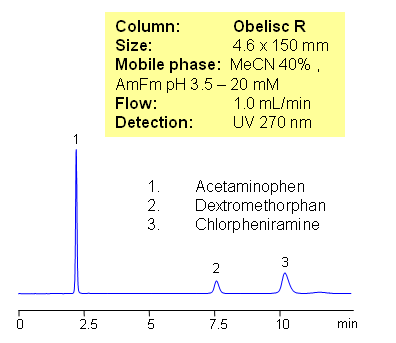
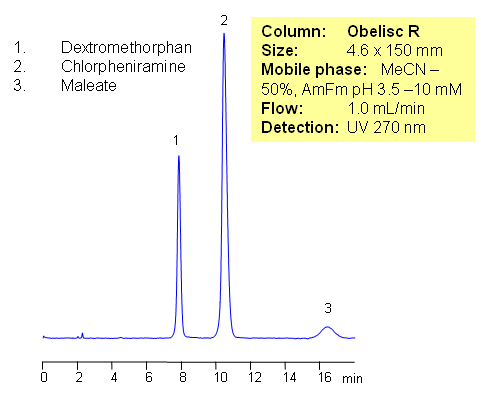
Obelisc R column can be successfully used for analysis of hydrophobic and hydrophilic basic and acidic drugs and corresponding counter-ions. This approach can be used for analysis of various cold and cough composition, pain killers, and other prescription and over-the-counter medications. Within pH 3-5, both cation- and anion mechanism are present on the column, along with hydrophobic interaction. Selectivity of this mixed-mode separation is controlled by the amount of acetonitrile, buffer concentration and buffer pH. Method is robust and reproducible, and can be used as a common HPLC method for analysis of drug molecules and compositions.
| Column | Obelisc R, 4.6×150 mm, 5 µm, 100A |
| Mobile Phase | MeCN |
| Buffer | AmFm |
| Flow Rate | 1.0 ml/min |
| Detection | UV, 270 nm |
| Class of Compounds |
Drug, Analgetic, Acid, Hydrophilic, Ionizable, |
| Analyzing Compounds | Maleate, Chlorpheniramine, Dextromethorphan |
Application Column
Obelisc R
SIELC has developed the Obelisc™ columns, which are mixed-mode and utilize Liquid Separation Cell technology (LiSC™). These cost-effective columns are the first of their kind to be commercially available and can replace multiple HPLC columns, including reversed-phase (RP), AQ-type reversed-phase, polar-embedded group RP columns, normal-phase, cation-exchange, anion-exchange, ion-exclusion, and HILIC (Hydrophilic Interaction Liquid Chromatography) columns. By controlling just three orthogonal method parameters - buffer concentration, buffer pH, and organic modifier concentration - users can adjust the column properties with pinpoint precision to separate complex mixtures.
Select optionsDextromethorphan

HPLC Analysis of Drugs in Saliva
August 22, 2010

The presence of three drugs, dextromethorphan, amitriptyline and trimipramine in saliva were analyzed by mixed-mode chromatography on a Primesep D reversed-phase anion-exchange column. No sample preparation is required as proteins from saliva are not retained at these conditions and elute in the void of the column due to cation-exclusion effect. Both column and proteins are positively charged at current conditions. Mobile phase consists of ACN-water-formic acid and is compatible with LC/MS detection technique. This general HPLC method can be used for analysis of hydrophobic basic drugs in biofluids.
Application Column
Primesep D
The Primesep family of mixed-mode columns offers a wide variety of stationary phases, boasting unprecedented selectivity in the separation of a broad array of chemical compounds across multiple applications. Corresponding Primesep guard columns, available with all stationary phases, do not require holders. SIELC provides a method development service available to all customers. Inquire about our specially-tailored custom LC-phases for specific separations.
Select optionsAmitriptyline
Dextromethorphan

Comparison of the Separation of Polar Drugs on Obelisc R and Zorbax SB-AQ
March 3, 2010
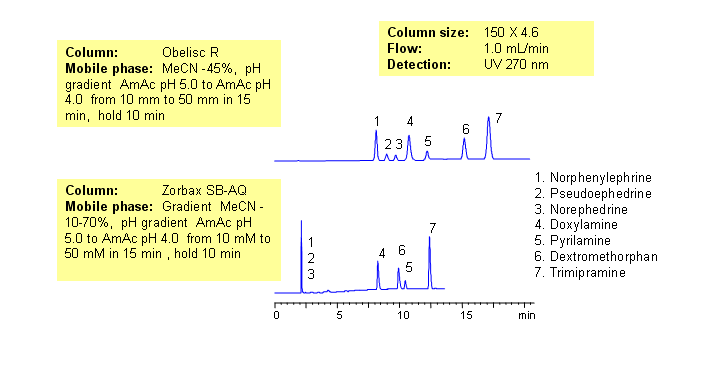
Common hydrophobic basic and hydrophilic basic drugs are separated by mixed-mode chromatography with greater selectivity and resolution than traditional reversed-phase column. Drugs are retained by combination of reversed-phase and cation-exchange mechanisms. Retention time is controlled by amount of acetonitrile, buffer concentration and buffer pH. Available detection techniques are based on buffer selection and include UV, Evaporative Light-Scattering Detector (ELSD), Corona (CAD), LC/MS, etc. This HPLC method can be adopted as general approach for analysis of drugs and pharmaceuticals.
Application Column
Obelisc R
SIELC has developed the Obelisc™ columns, which are mixed-mode and utilize Liquid Separation Cell technology (LiSC™). These cost-effective columns are the first of their kind to be commercially available and can replace multiple HPLC columns, including reversed-phase (RP), AQ-type reversed-phase, polar-embedded group RP columns, normal-phase, cation-exchange, anion-exchange, ion-exclusion, and HILIC (Hydrophilic Interaction Liquid Chromatography) columns. By controlling just three orthogonal method parameters - buffer concentration, buffer pH, and organic modifier concentration - users can adjust the column properties with pinpoint precision to separate complex mixtures.
Select optionsDextromethorphan
Doxylamine
Norephedrine
Norphenylephrine
Pseudoephedrine (PSE)
Pyrilamine

HPLC Analysis of Basic Drugs and Acidic Counter-Ions by Mixed-Mode Chromatography
July 16, 2009
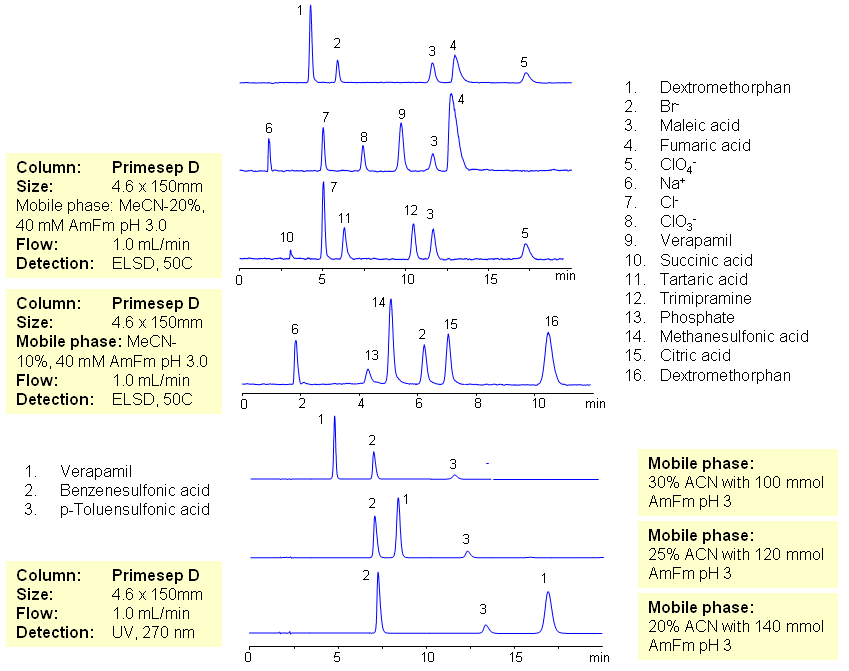
The majority of drugs in the pharmaceutical industry are administered in salt form. The presence of two counter-ions very often necessitates the use of two methods. The nature of these counterparts in drugs can be an inorganic cation and organic acid, inorganic anion and organic base, and organic cation and organic anion. Furthermore, the properties of the molecules will result in a differing stoichiometry. The task of simultaneous quantitation of counter-ions can be achieved by using mixed-mode columns. The general approach for analysis is based on properties of corresponding counter-ions. Hydrophobic basic drugs, like dextromethorphan, verapamil, trimipramine, and corresponding acidic counter-ions (chloride, chlorate, bromide, bromate, perchlorate, maleate, fumarate,tartrate, succinate, phosphate, citrate, benzosulfonate, toleuensulfonate) can be separated and quantitated in the same run on reversed-phase anion-exchange column. Basic hydrophobic drugs are retained by the reversed-phase mechanism, and counter-ions are retained by the reversed-phase and anion-exchange mechanism. Some polar counter-ions are retained only by the anion-exchange mechanism. Retention time and selectivity of HPLC separation of drugs and counter-ions can be achieved by changing the amount of acetonitrile and the amount of ions in the mobile phase. The detection technique depends on the properties of the counter-ions. In case of low or no UV activity, ELSD can be employed if the counter-ion forms a non-volatile salt with the mobile phase additive (ammonium formate). This HPLC method can be used for simultaneous quantitation of other basic drugs and counter-ions. The presence of two mechanisms of retention allows control over retention times of drug and counter-ion independently, and even allows a change of order of elution when necessary.
| Column | Primesep D , 4.6×150 mm, 5 µm, 100A |
| Mobile Phase | MeCN/H2O |
| Buffer | AmFm pH 3.0 |
| Flow Rate | 1.0 ml/min |
| Detection | ELSD, UV 270 |
| Class of Compounds | Ions, Hydrophilic, Hydrophobic, Base, Acids, Ionizable |
| Analyzing Compounds | Sodium Chloride, Sodium chloride, Sodium Chlorate, Sodium bromide, Sodium bromate, Perchloric Acid, Maleic Acid, Fumaric Acid, Tartaric Acid, Succinic Acid, Phosphoric Acid, Citric acid, Benzosulfonic acid, Dextromethorphan, Verapamil, Trimipramine |
Application Column
Primesep D
The Primesep family of mixed-mode columns offers a wide variety of stationary phases, boasting unprecedented selectivity in the separation of a broad array of chemical compounds across multiple applications. Corresponding Primesep guard columns, available with all stationary phases, do not require holders. SIELC provides a method development service available to all customers. Inquire about our specially-tailored custom LC-phases for specific separations.
Select optionsBromide
Chlorate
Chloride
Citric Acid
Dextromethorphan
Fumaric Acid
Maleic Acid
Organic Acids
Perchlorate
Phosphoric Acid
Pyrilamine
Succinic Acid
Tartaric Acid
Verapamil
p-Toluenesulfonic Acid (PTSA)
UV Detection

HPLC Separation of Drugs in Tylenol Cold and Cough Remedies
August 22, 2008
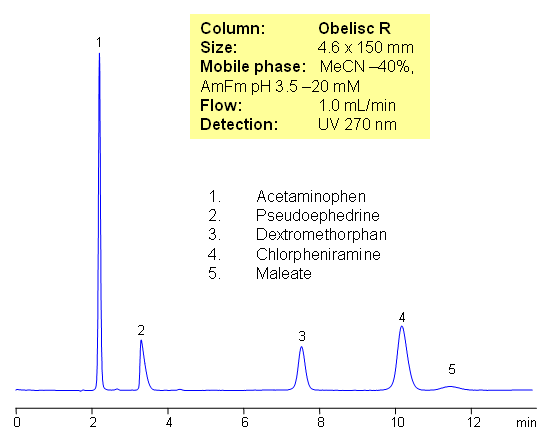
Components of Tylenol Cold and Cough Remedy are separated on Obelisc R mixed-mode column. Method can be used to determine compounds in various cough and cold compositions. Neutral (acetaminophen), basic (chlorpheniramine, dextromethorphan and pseudoephedrine) and acidic (maleic acid/Maleate) components are analyzed with perfect peak shape and retention control. Method can be used in production, QC/QA and biological studies for quantitation of various components in pharmaceutical formulations (Advil, Tylenol, Dimetapp, Robitussin, NyQuil, etc)
| Column | Obelisc R, 4.6×150 mm, 5 µm, 100A |
| Mobile Phase | MeCN |
| Buffer | AmFm |
| Flow Rate | 1.0 ml/min |
| Detection | UV, 270 nm |
| Class of Compounds |
Drug, Analgetic, Acid, Hydrophilic, Ionizable, Neutral, Basic |
| Analyzing Compounds | Maleate, Chlorpheniramine, Dextromethorphan, Pseudoephedrine, Acetaminophen |
Application Column
Obelisc R
SIELC has developed the Obelisc™ columns, which are mixed-mode and utilize Liquid Separation Cell technology (LiSC™). These cost-effective columns are the first of their kind to be commercially available and can replace multiple HPLC columns, including reversed-phase (RP), AQ-type reversed-phase, polar-embedded group RP columns, normal-phase, cation-exchange, anion-exchange, ion-exclusion, and HILIC (Hydrophilic Interaction Liquid Chromatography) columns. By controlling just three orthogonal method parameters - buffer concentration, buffer pH, and organic modifier concentration - users can adjust the column properties with pinpoint precision to separate complex mixtures.
Select optionsChlorpheniramine
Dextromethorphan
Maleate
Pseudoephedrine (PSE)

HPLC Separation of Drugs in Advil Allergy and Sinus
August 22, 2008
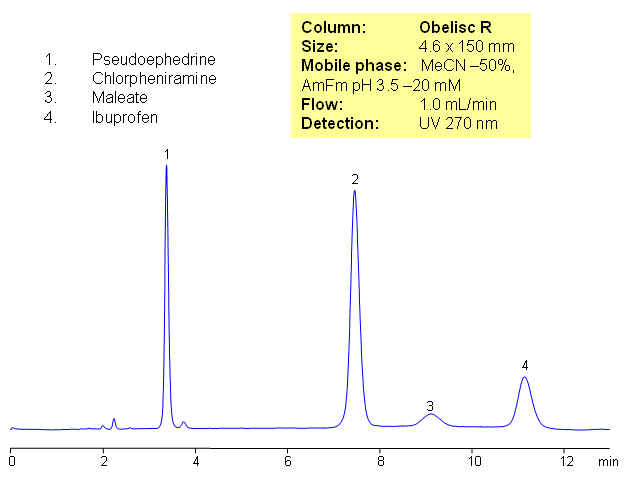
Ibuprofen is in a group of drugs called non-steroidal anti-inflammatory drugs (NSAIDs). Ibuprofen works by reducing hormones that cause inflammation and pain in the body.
Pseudoephedrine is a decongestant that shrinks blood vessels in the nasal passages. Dilated blood vessels can cause nasal congestion (stuffy nose).
The combination of chlorpheniramine, ibuprofen, and pseudoephedrine is used to treat sneezing, itching, watery eyes, runny nose, stuffy nose, sinus congestion, cough, and pain or fever caused by the common cold or flu in common over-the-counter medication (Advil, NyQuil, Tylenol, etc.)
Active ingredients of Advil Allergy and Sinus composition are separated by combination of reverse phase, cation-exchange and anion exchange mechanisms. Obelisc R mixed-mode column is used to separate pseudoephedrine (polar basic compound), chlorpheniramine (hydrophobic basic compound), ibuprofen (hydrophobic acidic compound) and maleic acid (counter-ion, hydrophilic acid compound). Method can be used for QC in production, impurity profiling and research and development. All compounds are well separated with high efficiency and good peak shape. Method uses ammonium formate buffer but other buffers can be used as well (ammonium acetate, sodium and ammonium phosphate) with corresponding detection technique – ELSD, LC/MS, and UV. Chlorpheniramine is an antihistamine that reduces the natural chemical histamine in the body. Histamine can produce symptoms of sneezing, itching, watery eyes, and runny nose.
Application Column
Obelisc R
SIELC has developed the Obelisc™ columns, which are mixed-mode and utilize Liquid Separation Cell technology (LiSC™). These cost-effective columns are the first of their kind to be commercially available and can replace multiple HPLC columns, including reversed-phase (RP), AQ-type reversed-phase, polar-embedded group RP columns, normal-phase, cation-exchange, anion-exchange, ion-exclusion, and HILIC (Hydrophilic Interaction Liquid Chromatography) columns. By controlling just three orthogonal method parameters - buffer concentration, buffer pH, and organic modifier concentration - users can adjust the column properties with pinpoint precision to separate complex mixtures.
Select optionsIbuprofen
Maleate
Pseudoephedrine (PSE)

HPLC Method for Analysis of Dextromethorphan Bromide on Primesep B2 column
May 5, 2005
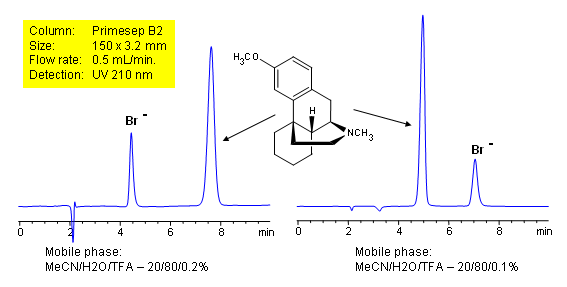
Dextromethorphan is used as a temporary cough suppressant in many medications. The elution time of dextromethorphan and bromide can be reversed in HPLC chromatography on a Primesep B2 reverse-phase (RP) column with embedded basic ion-pairing groups by only changing the concentration of buffer in a simple mobile phase of water and acetonitrile (MeCN, ACN). Buffer is trifluoroacetic acid (TFA). UV detection at 210nm.
Application Column
Primesep B2
Column Diameter: 3.2 mm
Column Length: 150 mm
Particle Size: 5 µm
Pore Size: 100 A
Dextromethorphan

Separation of NyQuil Active Ingredients on Primesep C
March 2, 2004
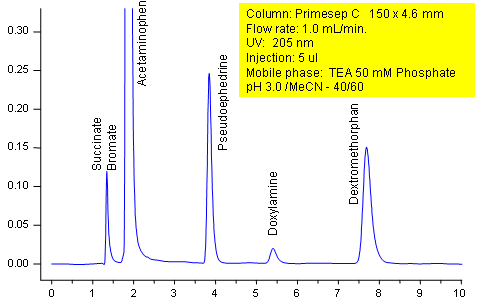
Primesep C separates the active ingredients in the over-the-counter cold medicine, NyQuil. Succinate and bromate co-elute early, but acetaminophen, pseudoephedrine, doxylamine, and dextromethorphan are baseline resolved. A combination of cation exchange, complex formation, and hydrophobic interactions separate this mixture with a mobile phase of water, acetonitrile (MeCN, ACN) and triethylamine (TEA) phosphate with UV detection at 205 nm.
| Column | Primesep C, 4.6×150 mm, 5 µm, 100A |
| Mobile Phase | MeCN |
| Buffer | TEAPh |
| Flow Rate | 1.0 ml/min |
| Detection | UV, 205 nm |
| Class of Compounds |
Drug, Analgetic, Acid, Hydrophilic, Ionizable, |
| Analyzing Compounds | Acetaminophen, Pseudoephedrine, Doxylamine, Dextromethorphan |
Application Column
Primesep C
The Primesep family of mixed-mode columns offers a wide variety of stationary phases, boasting unprecedented selectivity in the separation of a broad array of chemical compounds across multiple applications. Corresponding Primesep guard columns, available with all stationary phases, do not require holders. SIELC provides a method development service available to all customers. Inquire about our specially-tailored custom LC-phases for specific separations.
Select optionsDextromethorphan
Doxylamine
Pseudoephedrine (PSE)

